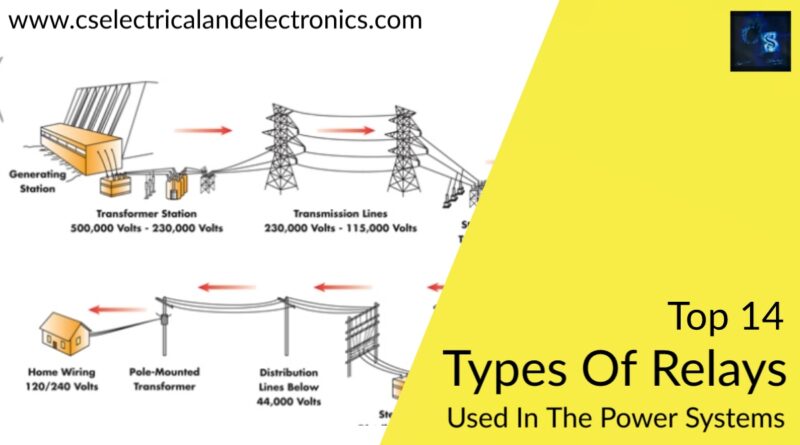Top 14 Types Of Relay In Power Systems, Working, Purpose
Hello guys, welcome to my blog. In this article, I will discuss the top 14 types of relay in power systems, the basic working principles of relays, what is the purpose of the relay, etc.
If you have any doubts related to electrical, electronics, and computer science, then ask questions. You can also catch me on Instagram – CS Electrical & Electronics And Chetan Shidling.
Also, read:
- Fuel Cell Working, Applications, Types, Advantages, Disadvantages
- Top 150 Simulink Projects For Electrical Engineers, MTech Students 2022
- Top 15 IoT Projects For Electrical Engineers, Electrical Engineering Project
Types Of Relay In Power Systems
Relay is one type of protecting device which is majorly used for locating the faults in the electrical equipment. The relay will locate the faults in the power system by measuring the electrical parameters during normal and abnormal conditions. It is also used to send signals to circuit breakers to break the circuit when a fault occurs in the power system. The faults that occurred may be internal or external they were caused due to the equipment failure or input parameters differences. These faults will create intolerable conditions in the power system which leads to the damage of the equipment or losses during the generation, transmission, and distribution in the power systems.
The main concept of the relay is to limit the destruction by fault and used it to break the circuit in some conditions. A relay will not operate in normal conditions but it will act with immediate effect when abnormal conditions occur in the power system. The relay protective system should be capable of responding to the abnormalities irrespective of the number. But coming to the practice in the power system network the relays will respond by comparing the risks in the faults otherwise some of the compromises were made according to the effect of the fault. Relay is an automated device that closes its contacts when it senses the abnormal condition with the help of a circuit breaker. Below are some of the factors related to the Relays :
- Actuating Signal: The value which is greater than the threshold value which makes the relay operate is called as the Actuating signal.
- Operating Time: The actuating signal will operate the relay and then the relay starts it work, the working time of the relay for tripping the circuit is called as the operating time.
- Reset Value: The value of current or voltage which makes the relay to come back to its original position.
Types Of Relays
The relays are majorly classified into different categories such as working mechanisms, electrical parameters, and logic of protections. Coming to the working mechanism classification of the protective relays they are majorly classified into three types as mentioned below:
01. Electromagnetic Relays:
An electromagnetic relay works on the principle of Faraday’s laws of electromagnetic induction. Electromagnetic relays consist of mechanical and electrical relays. Electromagnetic relays mainly consist of operating relay and mechanical contacts. The coil will be energized during the abnormal condition which will lead to the close of mechanical contacts this is the major working of electromagnetic relays.
02. Static Relays:
These static relays will perform the operations without moving the parts. The efficiency will be very high and the power losses are also less compared to the electromagnetic relays. The main switching operation will be done with the solid-state components.
03. Digital Relays:
Digital relays are the combination of electromagnetic relays with some electronic components built in them which are also called hybrid relays. The input and output will be in digital mode.
Classification of relays according to the electrical parameters in the power system:
04. Current Relays:
The current relay is majorly operated on considering the current value of the electrical equipment. The abnormal conditions in the current parameter will lead to faults in the power system which will be rectified using the current relay.
05. Voltage Relays:
The voltage relay is majorly operated on considering the voltage value of the electrical equipment. The abnormal conditions in the voltage parameter will lead to faults in the power system which will be rectified using the voltage relay.
06. Frequency Relays:
The frequency of the electrical quantities should be maintained according to rating otherwise it will lead to abnormal conditions in the electrical quantities and then this frequency relay will react to the conditions in the electrical power system.
07. Power Relays:
Power is the most important parameter in the power system as changes in the power value will lead to abnormal conditions. The power relay will operate when the changes occur in the power value in the power system.
Classification of the protective relays according to the application in the power system:
08. Primary Relays:
The primary relay is the first relay placed in the network of the power system for protection. These primary relays will react very fast when the faults occur so the operating time will be very less. The primary relay is the first relay to react during abnormal conditions.
09. Backup Relays:
The backup relay is the backup protection for the power system which only operates when the primary relay fails. The backup relay is attached to the primary relay so its operating time will be high as it works slowly compared to the primary relay. The backup relay operates only when the primary relay fails to work.
The above mentioned are the different types of protective relays in the power system. The protective relays are many according to the type of protection and the logic of protection to be done. Below are some of the relays according to the protection of different parameters mentioned:
10. The Buchholz relay is used to detect the internal faults in the transformer.
11. The Overload relay is used to detect abnormal conditions in electrical equipment due to changes in the load.
12. The Differential relay is used to detect the changes in the voltages and current values in the transformer.
13. The Over-current and Overvoltage relays are used to detect when the values when the value exceeds the rated value of the equipment.
14. The distance relays and impedance relays are used in the transmission of the power system to monitor the different parameters of the power system.
There are different types of relays in the power system that operate according to the need but above mentioned are the most used and classified relays of the power transformer. The protective relays in the power system play the most crucial role as they protect the equipment of the power system.
This was about “Types Of Relay In Power Systems“. I hope this article may help you all a lot. Thank you for reading.
Also, read:
- 10 Tips To Maintain Battery For Long Life, Battery Maintainance
- 10 Tips To Save Electricity Bills, Save Money By Saving Electricity
- 100 (AI) Artificial Intelligence Applications In The Automotive Industry
- 100 + Electrical Engineering Projects For Students, Engineers
- 1000+ Control System Quiz, Top MCQ On Control System
- 1000+ Electrical Machines Quiz, Top MCQs On Electrical Machines
- 1000+ MATLAB Simulink Projects For MTech, Engineering Students
- 50 Tips To Save Electricity At Home, Shop, Industry, Office
Author Profile
- Chetu
- Interest's ~ Engineering | Entrepreneurship | Politics | History | Travelling | Content Writing | Technology | Cooking
Latest entries
 All PostsApril 29, 2024Top 11 Free Courses On Battery For Engineers With Documents
All PostsApril 29, 2024Top 11 Free Courses On Battery For Engineers With Documents All PostsApril 19, 2024What Is Vector CANoe Tool, Why It Is Used In The Automotive Industry
All PostsApril 19, 2024What Is Vector CANoe Tool, Why It Is Used In The Automotive Industry All PostsApril 13, 2024What Is TCM, Transmission Control Module, Working, Purpose,
All PostsApril 13, 2024What Is TCM, Transmission Control Module, Working, Purpose, All PostsApril 12, 2024Top 100 HiL hardware in loop Interview Questions With Answers For Engineers
All PostsApril 12, 2024Top 100 HiL hardware in loop Interview Questions With Answers For Engineers








